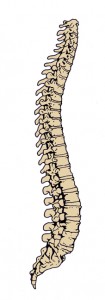 I think it might be spine week here at the CoreWalking blog. I hope to write about twisting and facet joints, the diaphragm, and maybe the meninges. So let’s start with an overview.
I think it might be spine week here at the CoreWalking blog. I hope to write about twisting and facet joints, the diaphragm, and maybe the meninges. So let’s start with an overview.
The adult spine consists of four segments, and though we look at the spine as a whole, these four segments are very different from one another.
There is a great deal of variation between the shapes and sizes, and the different sections afford different capabilities for movement.
Our spine is an extraordinary conglomeration of bones—solid when we want it to be (plank) and supple when we want it to move (cat and cow). The quality of its movement comes from the tonus of the ligaments that hold the bones together and the muscles that support the alignment of the bones.
Starting from the bottom, we divide the spine into four sections:
- Sacrum and coccyx– When we are born, the sacrum and coccyx are five to ten bones. Within our first couple of years, they will solidify into two distinct bones with a movable joint between them. The Coccyx is three to five bones that form the tailbone. Five bones above the coccyx calcify into the sacrum. The sacrum is both part of the spine and part of the pelvis.
- Lumbar- the five vertebrae above the sacrum make up the lumbar spine or lower back. These are the five largest bones of the spinal column, as they are most responsible for bearing and transferring weight through the spine into the legs.
- Thoracic- The rib cage attaches to the twelve vertebrae of the middle back. The thoracic spine and rib cage offer bony protection for the heart and lungs.
- Cervical– the seven cervical vertebrae are between the rib cage and the head. The top two vertebrae, the atlas and axis, while they are vertebrae, are shaped unlike any of their mates and offer a much greater range of action to allow for the movements of the head.
The spine moves in four different ways:
- Flexion- Bending Forward
- Extension- Lengthening Up
- Lateral Flexion- Side bending
- Rotation- Twisting
The different sections of the spine, however, have lesser or greater access to the above movements. The sacrum and coccyx don’t have access to these movements as the sacrum is five calcified bones that work as a gliding joint in the body. If the sacrum does move, it glides up and down the tiniest bit within the hip joints.
The five bones of the lumbar spine are meant to support and transfer weight from the bones above to the bones below. Because of this, there is very little rotational movement available to these vertebrae. They flex, extend, and side bend but don’t have much twist.
The thoracic spine has more rotational access than the lumbar spine, though it has less access to extension. If you look at a picture of the thoracic vertebrae, you will see the spinous processes, the bones jutting out of the back of the spine, lying down over the vertebrae below them.
This limits the ability of the spine to bend backwards in order to protect our vital organs.
The cervical spine has the greatest range of motion in the spine. It moves in all four planes, as well as having the aforementioned atlas and axis as the top vertebrae. These bones, the top of the spine, allow for the head to move forward and turn side to side.
We need to be aware of what is available in the spine when we work on twisting it in yoga class and even in life. You can’t imagine how many injuries I have encountered from people twisting backwards in the wrong way to parallel park a car. The next few posts will focus on twisting and more about the spine.
